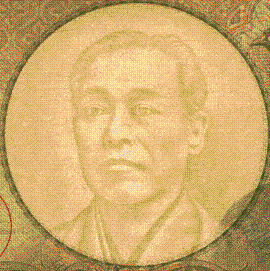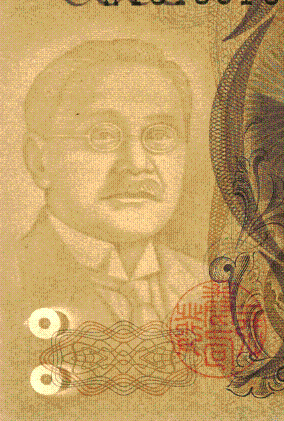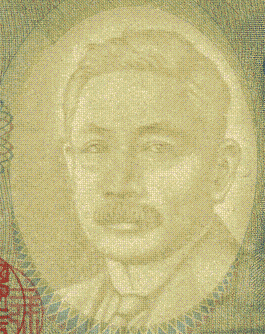Security Features of Bank of Japan Notes- 10,000 yen Note (Yukichi Fukuzawa), 5,000 yen Note (Inazo Nitobe) and 1,000 yen Note (Soseki Natsume) -
December 3, 2012
Bank of Japan
10,000 yen Note
- Portrait : Yukichi Fukuzawa
- Size : 76×160mm
- Date of first issue : Nov. 1, 1984
- Issue suspended : Apr. 2, 2007

front
back
5,000 yen Note
- Portrait : Inazo Nitobe
- Size : 76×155mm
- Date of first issue : Nov. 1, 1984
- Issue suspended : Apr. 2, 2007

front
back
1,000 yen Note
- Portrait : Soseki Natsume
- Size : 76×150mm
- Date of first issue : Nov. 1, 1984
- Issue suspended : Apr. 2, 2007

front
back
(1) Watermarks
Watermarks are created by producing variations in the thickness of the paper. Watermarks in Bank of Japan notes are elaborately produced using a unique technology. They include tactile marks to help the visually impaired people distinguish different denominations.
10,000 yen Note
Portrait : Yukichi Fukuzawa

Watermarks
Tactile marks
5,000 yen Note
Portrait : Inazo Nitobe

Watermarks
Tactile marks
1,000 yen Note
Portrait : Soseki Natsume

Watermarks
Tactile marks
(2) Ultrafine-line printing
Bank of Japan notes are minutely designed incorporating ultrafine-line printing. Such fine lines can hardly be replicated by ordinary printing equipment, or by color copiers or similar devices.

(3) Intaglio printing
Raised printing is used for selected parts of the design, such as the Chinese characters showing denomination and the portrait. Bank of Japan notes feel rough to the touch.

(4) Microprinting
With a magnifying glass, you can see the microprinted letters "NIPPON GINKO" ("Bank of Japan" in Japanese). This applies to notes with serial numbers in brown or dark green. The letters can hardly be reproduced by color copiers or similar devices.

(5) Luminescent ink
The red stamp on the side of the portrait glows orange under ultraviolet light. This applies to notes with serial numbers in brown or dark green. The stamp reads "the seal of the Governor (of the Bank of Japan)," written in an ancient calligraphic style.

